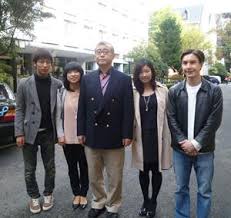Change in Osaka = Change for Japan?
- 2017/11/27 20:22



Q: Please explain the thinking behind the Osaka Metropolis Scheme, as well as its impacts on Japanese society should it be realized.
A: (Professor Ueyama) The Osaka Metropolis Scheme isn’t just about Osaka, it is about changing Japan from a “one state, one system” structure – a structure that has continued for 140 years since the Meiji Restoration – to a “one state, multi-system” structure. I believe everyone feels that if we continue under the present system, where the state controls everything from the center, it will be difficult to respond to an age of dramatic change. Power may have shifted from the Liberal Democratic Party (LDP) to the Democratic Party of Japan (DPJ), but the core system of the country has not changed, meaning there will be no reform.
However, it is not possible to change this system as long as the regions remain economically dependent on the state. Therefore, in the “Osaka Metropolis Scheme”, we will first streamline the prefectural and city administrations and cut waste, then under the one plan effectively utilize the assets of Osaka Prefecture and Osaka City to revitalize the economy. Osaka Prefecture’s current debt is 10 trillion yen, but if you combine prefectural and city assets, then you have a total of 16 trillion yen. In particular, Osaka City owns an astounding 25 percent of the land within the city. If we utilize this asset effectively it would not be difficult to attract outside investment. Also, if the prefecture and city cooperate we would also be able to create more efficient infrastructure. In countries that are currently growing economically, it is not the state that guides everything but rather the leaders of large metropolises who use their own discretion to implement new policies and bring in investment from overseas and private companies. If Osaka shows its new growth model to other regions, then we should see similar moves in the Kyushu, Chukyo, and Tokyo areas also.
Q: That’s an amazing scheme. However, living in Japan (Tokyo), I feel the Japanese are conservative, so even if they agree with the concept, won’t it will be difficult to turn the plan into action?
A: It’s certainly not simple. However, I have many colleagues in various fields who are working in the same direction as me. Also, Osaka in a way isn’t really Japan (laughs). Historically, it is a flourishing commercial city, so without a more free and vibrant movement of people, goods and money, it cannot survive. Osakans also aren’t really sticklers for the rules; they are adaptive people. If anything, the more Asian in this sense. If Japan’s system becomes inflexible, it will eventually become easy for Japanese people to miss opportunities.It’s very difficult to change Japan as a whole. That's why we start from Osaka.
Q: There has been an increase in young people acting out of a desire to change society after the March 11 earthquake. As someone promoting the Osaka Metropolis Scheme, do you have any advice for them?
A: There is also a need for young Japanese to change their mindsets. The best way to do this is to live overseas. If you view Japan from the outside, I think you can really feel the differences in other systems and ways of thinking. Society does not change easily (laughs). First, you should start by steadily changing your immediate environment. In order to do this you need to acquire the necessary societal skills, try them out, and learn how to be persuasive. I began thinking about the “Osaka Metropolis Scheme” 10 years ago. I occasionally had setbacks on the way, but if you believe in your aspirations, then chances will come your way. Even if you make mistakes, if you’re willing to openly admit to them, you will find people willing to help you. If you have aspirations, it’s important to not let yourself get upset and instead progress forward in a positive manner.
Also, I would like young people to have more of an interest in politics. Looking at the newspapers and TV, politicians don’t seem very appealing, but if you speak to them individually, many of them are very bright. However, when you get them all together, the Japanese group mentality takes over and you can’t see this. In order to change this situation, I would like young people – regardless of nationality – to take more a proactive interest in Japanese society and politics.
There would be very few people who think Japanese society is fine the way it is. It’s becoming more difficult even for young people to hold bright hopes for the future. In this way, I hope that if interest in the “Osaka Metropolis Scheme” acts as a catalyst for young people to develop a clear vision (for the future), then no matter how difficult, a “can-do spirit” will spread throughout Japan.
translated by Lance Truong (Monash Univ)